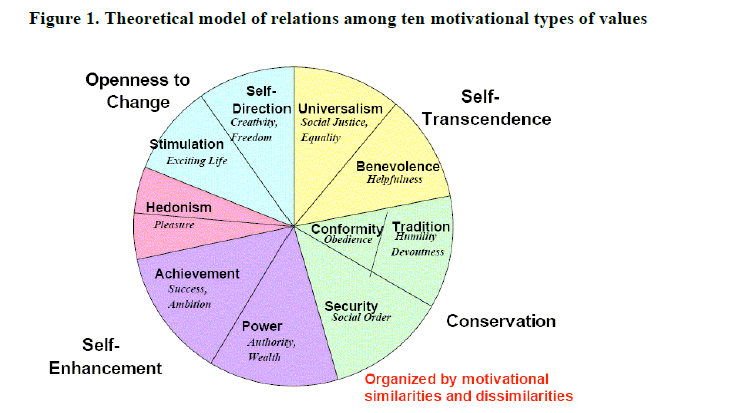SKEDSOFT
Introduction to the Values Theory: When we think of our values, we think of what is important to us in our lives (e.g., security, independence, wisdom, success, kindness, pleasure). Each of us holds numerous values with varying degrees of importance. A particular value may be very important to one person, but unimportant to another. Consensus regarding the most useful way to conceptualize basic values has emerged gradually since the 1950’s. We can summarize the main features of the conception of basic values implicit in the writings of many theorists and researchers2 as follows:
- Values are beliefs. But they are beliefs tied inextricably to emotion, not objective, cold ideas.
- Values are a motivational construct. They refer to the desirable goals people strive to attain.
- Values transcend specific actions and situations. They are abstract goals. The abstract nature of values distinguishes them from concepts like norms and attitudes, which usually refer to specific actions, objects, or situations.
- Values guide the selection or evaluation of actions, policies, people, and events. That is, values serve as standards or criteria.
- Values are ordered by importance relative to one another. People’s values form an ordered system of value priorities that characterize them as individuals. This hierarchical feature of values also distinguishes them from norms and attitudes.
The Values Theory defines values as desirable, trans-situational goals, varying in importance, that serves as guiding principles in people’s lives. The five features above are common to all values. The crucial content aspect that distinguishes among values is the type of motivational goal they express. In order to coordinate with others in the pursuit of the goals that are important to them, groups and individuals represent these requirements cognitively (linguistically) as specific values about which they communicate. Ten motivationally distinct, broad and basic values are derived from three universal requirements of the human condition: needs of individuals as biological organisms, requisites of coordinated social interaction, and survival and welfare needs of groups. The ten basic values are intended to include all the core values recognized in cultures around the world. These ten values cover the distinct content categories found in earlier value theories, in value questionnaires from different cultures, and in religious and philosophical discussions of values. It is possible to classify virtually all the items found in lists of specific values from different cultures, into one of these ten motivationally distinct basic values. Schwartz [Schwartz, 1992, 2005a] details the derivations of the ten basic values. For example, a conformity value was derived from the prerequisites of interaction and of group survival. For interaction to proceed smoothly and for groups to maintain themselves, individuals must restrain impulses and inhibit actions that might hurt others. A self-direction value was derived from organismic needs for mastery and from the interaction requirements of autonomy and independence. Each of the ten basic values can be characterized by describing its central motivational goal:
- Self-Direction: Independent thought and action; choosing, creating, exploring.
- Stimulation: Excitement, novelty, and challenge in life.
- Hedonism: Pleasure and sensuous gratification for oneself.
- Achievement: Personal success through demonstrating competence according to social standards.
- Power: Social status and prestige, control or dominance over people and resources.
- Security: Safety, harmony, and stability of society, of relationships, and of self.
- Conformity: Restraint of actions, inclinations, and impulses likely to upset or harm others and violate social expectations or norms.
- Tradition: Respect, commitment, and acceptance of the customs and ideas that traditional culture or religion provide the self.
- Benevolence: Preserving and enhancing the welfare of those with whom one is in frequent personal contact (the ‘in-group’).
- Universalism: Understanding, appreciation, tolerance, and protection for the welfare of all people and for nature
The comprehensiveness of any set of value orientations in covering the full range of motivational goals cannot be tested definitively. However, some evidence is consistent with the comprehensiveness of the ten basic values. Local researchers in 18 countries added to the survey value items of significance in their culture that they thought might be missing. These were assigned a priori to the existing basic values whose motivational goals they were expected to express. Analyses including the added value items revealed that these items correlated as expected with the core, marker items from the basic values to which they were assigned. They identified no additional basic values.
The Structure of Value Relations:
In addition to identifying ten motivationally distinct basic values, the Values Theory explicates a structural aspect of values, namely, the dynamic relations among them. Actions in pursuit of any value have psychological, practical, and social consequences that may conflict or may be congruent with the pursuit of other values. For example, the pursuit of achievement values may conflict with the pursuit of benevolence values - seeking success for self is likely to obstruct
actions aimed at enhancing the welfare of others who need one's help. However, the pursuit of achievement values may be compatible with the pursuit of power values - seeking personal success for oneself is likely to strengthen and to be strengthened by actions aimed at enhancing one's own social position and authority over others. Another example: The pursuit of novelty and change (stimulation values) is likely to undermine preservation of time-honoured customs (tradition values). In contrast, the pursuit of tradition values is congruent with the pursuit of conformity values: Both motivate actions of submission to external expectations. The circular structure in Figure 1 portrays the total pattern of relations of conflict and congruity among values postulated by the theory. The circular arrangement of the values represents a motivational continuum. The closer any two values in either direction around the circle, the more similar their underlying motivations. The more distant any two values, the more antagonistic their underlying motivations.
